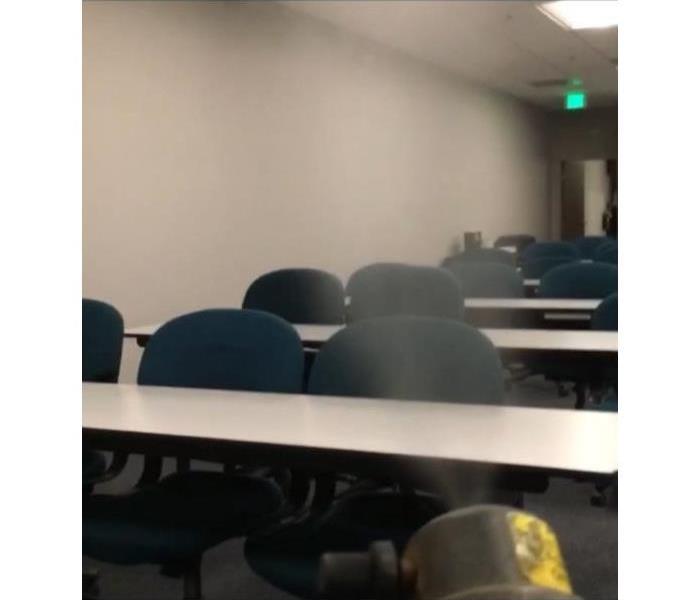Can you Clean Porous Materials as you do Non-porous Surfaces?
5/27/2020 (Permalink)
 Here we use we used a ULV fogger that can mist the disinfectant to as small as 20 microns in size to get into hard to reach areas.
Here we use we used a ULV fogger that can mist the disinfectant to as small as 20 microns in size to get into hard to reach areas.
The CDC describes cleaning as removing germs, dirt, and impurities from surfaces or objects.
The CDC describes cleaning as removing germs, dirt, and impurities from surfaces or objects. Cleaning works by using a detergent and water to physically remove germs from surfaces. This process does not necessarily kill germs, but by removing them, it lowers their numbers and the risk of spreading infection.
Some materials cannot be cleaned with detergent and water without being damaged. For this reason, paper and paper products are not able to be cleaned and/or disinfected. Cleaning methods typically used on water sensitive materials such as vacuuming or dry sponging would not be capable of removing enough soil and residue to be effective.
Porous materials like carpet, area rugs, upholstered items, and draperies that are not water sensitive, can be wet cleaned using a Hot Water Extraction or Deluxe Preconditioner and Rinse method. Carpets can also be sanitized with SERVPROXIDE™ (product #100) following label directions, if needed.
Non-porous materials like hard surface floors, cabinets, countertops, doorknobs, and plumbing fixtures can be wet cleaned using a variety of SERVPRO hard surface cleaners (general purpose cleaners) and cleaning methods.
Disinfecting of Non-porous Surfaces
The CDC describes disinfecting as killing germs on surfaces or objects. Disinfecting works by using chemicals to kill germs on surfaces or objects. This process does not necessarily clean dirty surfaces or remove germs, but by killing germs on a surface after cleaning, it can further lower the risk of spreading infection.
Not all surfaces can be disinfected. Because of the porosity of some materials, disinfection is not possible. This includes carpet, area rugs, upholstered items, and draperies.
Non-porous materials like hard surface floors, cabinets, countertops, doorknobs, and plumbing fixtures can be disinfected using a variety of disinfectants within the SERVPRO product line.
Currently there are no disinfectants that have been tested specifically for this particular emerging viral pathogen. The CDC recommends usage of a labeled Hospital Grade disinfectant with claims against viruses similar to SARS-CoV-2.
SERVPROXIDE™ (product #100) is a hospital-grade disinfectant that has demonstrated effectiveness against viruses similar to SARS-CoV-2 on hard, non-porous surfaces. Per the CDC, this product can be used against SARS-CoV-2 when used in accordance with the directions for use against Norovirus Feline Calicivirus and Canine Parvovirus, Strain Cornell-780916, ATCC VR2016 on hard, non-porous surfaces. In addition, SERVPROXIDE™ currently has EPA-approved claims for Feline coronavirus (Strain WSU 79-1683, ATCC VR 989) and Canine coronavirus (Strain 1-71, ATCC VR-809). As with all emerging-type pathogens, proper PPE use is of the utmost importance.
SERVPROXIDE™ should be used in accordance with label directions.
These disinfectants are normally applied using a spray bottle, pump-up sprayer, electric sprayer, or ULV Mister and must dwell on the surface for 10 minutes. Once again, follow label directions for the specific disinfectant being used.
The CDC encourages the use of disinfecting wipes on electronic items that are touched often, such as phones and computers. Pay close attention to the directions for using disinfecting wipes. It may be necessary to use more than one wipe to keep the surface wet for the stated length of contact time. Make sure that the electronics can withstand the use of liquids for cleaning and disinfecting. Consider Benefect Botanical Disinfectant Wipes for this purpose.
For more information about our Proactive Cleaning Services, call us at 951-351-8033!






 24/7 Emergency Service
24/7 Emergency Service